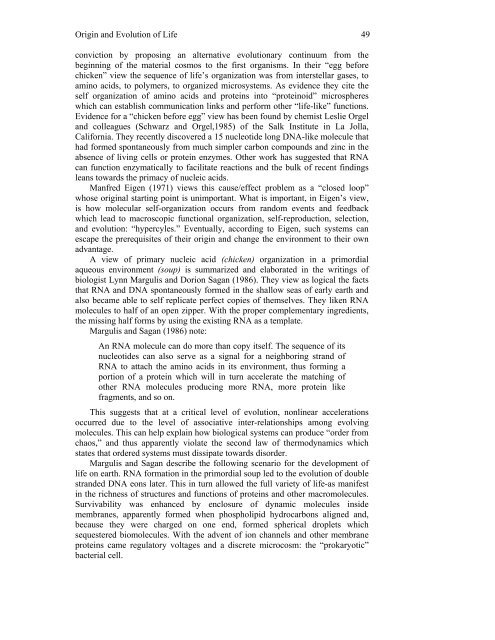ULTIMATE COMPUTING - Quantum Consciousness Studies
ULTIMATE COMPUTING - Quantum Consciousness Studies
ULTIMATE COMPUTING - Quantum Consciousness Studies
- No tags were found...
Create successful ePaper yourself
Turn your PDF publications into a flip-book with our unique Google optimized e-Paper software.
Origin and Evolution of Life 49<br />
conviction by proposing an alternative evolutionary continuum from the<br />
beginning of the material cosmos to the first organisms. In their “egg before<br />
chicken” view the sequence of life’s organization was from interstellar gases, to<br />
amino acids, to polymers, to organized microsystems. As evidence they cite the<br />
self organization of amino acids and proteins into “proteinoid” microspheres<br />
which can establish communication links and perform other “life-like” functions.<br />
Evidence for a “chicken before egg” view has been found by chemist Leslie Orgel<br />
and colleagues (Schwarz and Orgel,1985) of the Salk Institute in La Jolla,<br />
California. They recently discovered a 15 nucleotide long DNA-like molecule that<br />
had formed spontaneously from much simpler carbon compounds and zinc in the<br />
absence of living cells or protein enzymes. Other work has suggested that RNA<br />
can function enzymatically to facilitate reactions and the bulk of recent findings<br />
leans towards the primacy of nucleic acids.<br />
Manfred Eigen (1971) views this cause/effect problem as a “closed loop”<br />
whose original starting point is unimportant. What is important, in Eigen’s view,<br />
is how molecular self-organization occurs from random events and feedback<br />
which lead to macroscopic functional organization, self-reproduction, selection,<br />
and evolution: “hypercyles.” Eventually, according to Eigen, such systems can<br />
escape the prerequisites of their origin and change the environment to their own<br />
advantage.<br />
A view of primary nucleic acid (chicken) organization in a primordial<br />
aqueous environment (soup) is summarized and elaborated in the writings of<br />
biologist Lynn Margulis and Dorion Sagan (1986). They view as logical the facts<br />
that RNA and DNA spontaneously formed in the shallow seas of early earth and<br />
also became able to self replicate perfect copies of themselves. They liken RNA<br />
molecules to half of an open zipper. With the proper complementary ingredients,<br />
the missing half forms by using the existing RNA as a template.<br />
Margulis and Sagan (1986) note:<br />
An RNA molecule can do more than copy itself. The sequence of its<br />
nucleotides can also serve as a signal for a neighboring strand of<br />
RNA to attach the amino acids in its environment, thus forming a<br />
portion of a protein which will in turn accelerate the matching of<br />
other RNA molecules producing more RNA, more protein like<br />
fragments, and so on.<br />
This suggests that at a critical level of evolution, nonlinear accelerations<br />
occurred due to the level of associative inter-relationships among evolving<br />
molecules. This can help explain how biological systems can produce “order from<br />
chaos,” and thus apparently violate the second law of thermodynamics which<br />
states that ordered systems must dissipate towards disorder.<br />
Margulis and Sagan describe the following scenario for the development of<br />
life on earth. RNA formation in the primordial soup led to the evolution of double<br />
stranded DNA eons later. This in turn allowed the full variety of life-as manifest<br />
in the richness of structures and functions of proteins and other macromolecules.<br />
Survivability was enhanced by enclosure of dynamic molecules inside<br />
membranes, apparently formed when phospholipid hydrocarbons aligned and,<br />
because they were charged on one end, formed spherical droplets which<br />
sequestered biomolecules. With the advent of ion channels and other membrane<br />
proteins came regulatory voltages and a discrete microcosm: the “prokaryotic”<br />
bacterial cell.






